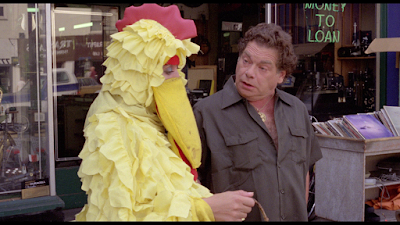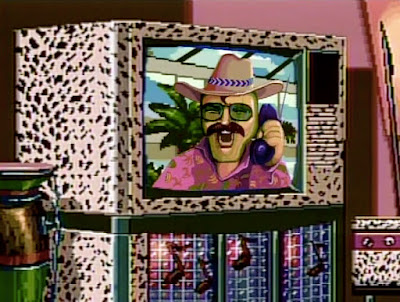 |
From http://vhscollector.com/sites/default/files
/vhscovers/microwavemassacre1.jpg |
Director: Wayne Berwick
Screenplay: Thomas Singer
Cast: Jackie Vernon (as Donald); Claire
Ginsberg (as May); Loren Schein (as Roosevelt); Al Troupe (as Philip); Karen
Marshall (as the Neighbour)
A Night of a Thousand Horror (Movies) #109
 Synopsis
Synopsis: After his tolerance for his wife May (
Ginsberg) and her failed attempts at
elaborate cuisine snaps, Donald (
Vernon)
in a drunken rage ends up killing her. When he accidentally eats one of her
chopped up body parts, he develops a taste for cannibalism which twists into
his redeveloping libido when he discovers he can still woo the opposite sex.
Microwave Massacre is not a popular film. When the American exploitation
oddity was recently re-released for a modern cult audience, many of the viewers
I've read have given it scathing reviews for the most part. Offensive or as
funny as a napalm enema, amateurish or just crass, dated junk. Yet it says
something peculiar within the film that, even if it's an inexplicable and tiny
cult, it still gets a lavish Blu-Ray restoration from Arrow Video and you have former Coil
member and film scholar (of American exploitation cinema especially) Stephen Thrower defending it in spite of
its immense flaws. Microwave Massacre
is a film, as documented, where after living within the culture of cinema for
his whole life, director Wayne Berwick
finally took the chance to make his own movie, only on the first day of
production to realise that the script for their serious horror film was full of
awful puns in the dialogue. In a moment where a production has a gun directly
pointed to its head, as other independent exploitation films from this era of
American cinema have had to face before them, the creators of Microwave Massacre decided to make as
intentionally as dumb and ridiculous a film as they could.
The issues with this are with the
humour that's of its time, including the terrible puns constantly in the
dialogue and puerile jokes about sex or stereotypes. One or two of them are
actually offensive for a modern viewer like me, but it feels within context of
the film of it being merely dumb as a movie and of its time. I've only been
offended by a couple of films morally for their attitudes - The Birth of a Nation (1915) for
obvious reasons, and Brother 2 (2000),
an already middling sequel to an interesting cult Russian crime film which,
after a sincere monologue about African Americans, becomes morally toxic in how
offensive the scene with that dialogue is. A film like Microwave Massacre in contrast is a film so desperate to pull
laughs that its stuck having to punch low below the belt. Most of the time its
instead a weird tone that works in its favour rather than anything truly
morally problematic, as most of the jokes are so poor they give the tone of
anti-humour by accident.
The result is closer, if it was
made in Britain, to a 70s British sex comedy of the era with a little bit more
gore, more sleaze, but the same disjointed view on good taste separated from
the modern day. It's an apt comparison with comedian Jackie Vernon in the lead. A figure who'll make the film more
shocking for American viewers due to having voiced Frosty the Snowman in
beloved Christmas animated specials in the US, he's at times almost in slow
motion alongside other performances, making it impossible for the jokes to work
regardless of the quality of the writing itself. If the original choice for the
lead was affordable, Rodney Dangerfield,
then even the tired "nagging wife" jokes would've had more spark in
them, and even added some credibility to an older, larger man being about
attract nubile, younger women due to his natural charisma. Other times however Vernon is perfect as long as a viewer
reads the film with Donald not being a sympathetic character. A lot of time
he's a bumbling dolt, but the only really likable moment in the whole film is
one scene, when he's stuck to eating dog food sandwiches because of his wife's
cooking, where he befriends a stray on the construction site he works for. For
the rest of the film however he's a useless chauvinist male from an era whose
wife, barring the terrible decision to try to cook elaborate food without enough
skill and with a stupidly large microwave, is completely innocent and his
midlife crisis becomes cannibalism by way of sex ritual.
 |
| From http://www.badmovies.org/movies/microwavem/microwavem6.jpg |
Technical Detail:
Helping the film is having been
made available on Blu-Ray with a pristine image, revealing in the current day
that, whilst the director's previous career as a documentary and public
information short director has a significant influence on the film, technical competent
but not attempting any risks on such a low budget in terms of elaborate camera
moments or editing, the production design gives the film a colourful, garish
kitsch that adds to the perversity of its tone. Having art and production
designer Robert A. Burns, famous for
his incredible and terrifying work on The
Texas Chain Saw Massacre (1974), helps so much in Microwave Massacre's favour. Donald's home feels like it's from a
sixties sexploitation movie rather than the late seventies when the film was
shot, and the general sense of colour the whole film has gives it a cartoonish
tone appropriate for such broad stereotypes and broad, dumb humour, giving the
failure of most of humour a more interesting tone of being alien, a suburban
environment where everyone acts with a disconnect of sitcom characters in a
deeply inappropriate and adult narrative.
Then there's the titular
microwave, a comically giant monstrosity where Donald can put multiple fake
arms and prosthetics in it at once (courtesy of Burns' effects, some of which he had no shame in recycling from
previous gigs). I originally found this, even for a horror comedy, utter absurd
until I heard a late seventies radio ad advertising a Sears microwave, suggesting the public could cook a whole lavish
dinner (pork chops, mashed potatoes, vegetables) within one to save time for
busy families. In the modern day, unless a microwave is all a household can
afford or fit in a very small apartment, the notion of a microwave replacing an
oven as the main tool of a kitchen is absurd, only seen now to defrost ingredients
to cook in an oven late or to heat up microwave food and leftovers, but at one
time there was a serious suggestion (at least from companies) suggesting they
were important new innovations. (This at least lasted into the late eighties,
as my parents still own a second print version a Hitachi Microwave Cookbook from 1988). Even Vernon's own stab at a
meaning to the film, documented in retrospective materials, that it's a warning
about modern technology corrupting people fits in how, for all Microwave Massacre's failings, it's a
gleefully perverse tale of a suburban white slob whose sex cannibalism murders,
including giving his co-workers the spare meat to eat, is helped by the ease of
using such a stupidly elaborate microwave. Even the subplot of the machine
effecting his pacemaker is an exaggeration of an actual fear with the machines
even if it seems ridiculous now.
 |
From http://www.thenerdmentality.com/wp-content/uploads/
2016/08/Microwave-Massacre-5-1024x576.png |
Abstract Spectrum: Grotesque/Psychotronic/Weird
Abstract Rating (High/Medium/Low/None): None
Unintentionally Microwave Massacre redeems itself for
me. Even with the fact, baring slashers, 'I'm fascinated with this period of
independent American horror cinema, Massacre
feels like with one nudge, and significantly better jokes, it would've been in
a kitsch, perverse view of middle or upper working class life, pissing on
suburbia as Donald does into the fireplace at one point out of frustration. While
its far from the weirdest films of this era, it's still a peculiar experience
where even the absolute pits stand out, stumbling through a deliberate lame
world such as Donald picking out a woman with an unknown foreign accent dressed
in the worst chicken costume you could ever see just for terrible poultry puns.
And some of the jokes do work.
Everything with the bartender at a strip joint, who hates people crying about
their terrible existences and talks about his haemorrhoids to get rid of
patrons is funny, as is Donald's female neighbour who is sexually liberated and
has many sex parties. Some of the later is the writing trying too hard, such as
her digging holes into her lawn to plant seeds with a vibrator, but the
introductory moment is perfect to try to find a tone to appreciate Microwave Massacre, where a male patron of an orgy at
the home, a cameo by one of the film's producers in women's underwear, closes
the curtains but still looks through at Donald with a disgusted look as if he's
the real deviant, proved by everything he commits no long afterwards.
 |
| From http://images4.static-bluray.com/reviews/13908_5.jpg |
Personal Opinion:
Microwave Massacre has to be approached with caution. Many have
rightly dismissed it as junk for its awful jokes, some that rightly you
couldn't get away with today, but like a lot of these films you can still gain
a lot from it even if its unintentional. For me, like many American
exploitation films, there's entertainment even in their failures and manage to
still show a picture of when they were made. It's a film many would
understandably feel embarrassed about seeing, but with its combination of
"take my wife" era jokes, crass eighties sex comedy (but with a
middle aged stand-up in the lead rather than a hunky, brainless male lead), and
moments of gore in the Herschel Gordon
Lewis mould are already a curious combination alongside strange,
unexplained moments such as a nude woman being smeared with mayonnaise than
covered with a giant piece of bread. It's a queer taste in terms of a movie,
but one that's appealing as much as it is scrapping the barrel for that reason.

 One of the more curious (and
obscurest) works I've covered on this blog or on 1000 Anime. A near hour long
film made entirely from 8-bit technology of a Japanese videogame console called
the MSX, The Flying Luna Clip is an
inherently strange creation, the limited animation and vibrant, bit colour in
elaborate detail already creating a fascinating tone before you get to the
actual content. A trip both in plot and effect - whose passengers include
snowmen, and anthropomorphic fruit and plants, flying in a plane boat around
the Hawaiian Pacific whilst also experiencing dreams that the viewer also
experience. The result is a haze with a tentative narrative, more a series of
scenes and incidents, even a musical number with singing volcanoes, but one
which for the most part is so innocuous and charming I felt love for it as a creation.
One of the more curious (and
obscurest) works I've covered on this blog or on 1000 Anime. A near hour long
film made entirely from 8-bit technology of a Japanese videogame console called
the MSX, The Flying Luna Clip is an
inherently strange creation, the limited animation and vibrant, bit colour in
elaborate detail already creating a fascinating tone before you get to the
actual content. A trip both in plot and effect - whose passengers include
snowmen, and anthropomorphic fruit and plants, flying in a plane boat around
the Hawaiian Pacific whilst also experiencing dreams that the viewer also
experience. The result is a haze with a tentative narrative, more a series of
scenes and incidents, even a musical number with singing volcanoes, but one
which for the most part is so innocuous and charming I felt love for it as a creation.










